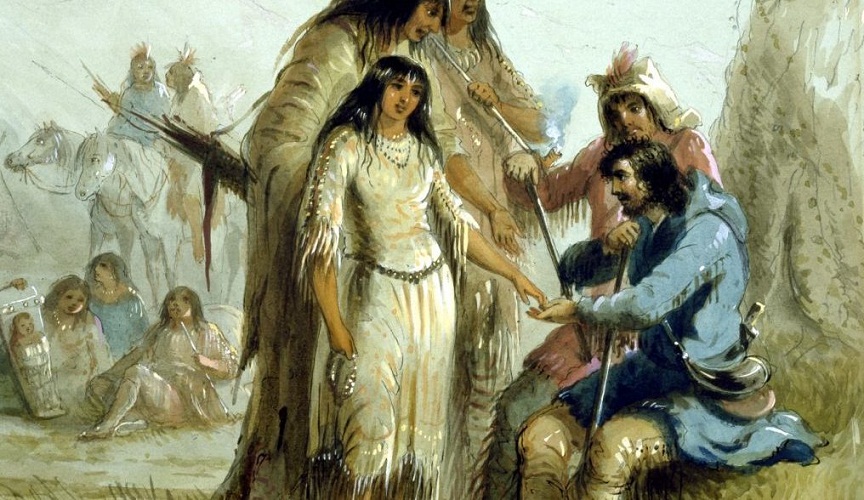
The debate over marriage in American society and the fears expressed by some conservatives that allowing diversity will somehow destroy the institution of marriage has been interesting (at some times amusing) to watch. While there appear to be some who feel that there is only one kind of marriage, in reality there are many options regarding marriage. In order to provide some additional depth to an understanding of the complexity of human marriage, I would like to discuss traditional Native American marriage.
First, however, a caution: at the beginning of the European invasion there were several hundred separate and distinct Indian cultures, each with their own view of marriage. I am about to talk about Indian marriage in very broad terms and realize that there are many exceptions to some of the generalizations which I’m about to make.
In American society, part of the discussion about marriage is really about sex. While sex was a part of traditional Native American marriage, marriage was not about sex. Prior to marriage, young people were expected to engage in sexual activities. Sex was not confined to marriage.
The Europeans, and particularly the missionaries, had a great deal of difficulty in understanding that women had power in Indian society and that they had the right to sexual freedom. Indian societies were not organized on the patriarchal, monogamous norms of European society. Christian missionaries were deeply shocked and offended by the fact that Indian women were allowed to express their sexuality. At the same time, many of the European men were delighted by this.
Among some contemporary American commentators, there is a view that there are only two genders: male and female. Yet, in American Indian cultures people did not make this an either/or situation. They viewed gender (and sexuality) as a continuum. Many modern Indians talk about a third sex/gender often called a berdache or two-spirit. Yet in traditional cultures, it wasn’t quite that simple. There was a recognition of the feminine and masculine in all people. There was not an either/or concept of being heterosexual or homosexual. There were in traditional societies male and female homosexuals and transvestites who played important spiritual and ceremonial roles. These individuals were seen as being an important part of the community.
Traditional Native American cultures tended to be egalitarian: all people were equal. This is one of the things that bothered many of the early Christian Missionaries, particularly the Jesuits in New France, as they viewed marriage as a relationship in which the woman subjugated herself to the man. In Indian marriages, men and women were equals.
Polygyny-the marriage of one man to more than one woman at the same time-was fairly common throughout North America. In some cases a man would marry sisters – a practice that anthropologists call sororal polygyny. In general, sisters tended to get along better than unrelated co-wives as sisters usually did not fight.
Former Navajo tribal chairman Peter MacDonald explains Navajo polygyny this way:
“A man would marry a woman, then work hard for his family. If she had a sister who was not married, and if the man proved to be caring, a good provider, and a good husband, he would be gifted with his wife’s sister, marrying her as well.”
Among many of the tribes a widow often married her deceased husband’s brother – a practice which anthropologists call the levirate. When a man’s wife died, he would often marry one of her sisters – a practice which anthropologists call the sororate.
Among many of the tribes, wife exchange was practiced. One man might become infatuated with the wife of another and propose an exchange. If this was agreeable, the two men would exchange wives from time to time. Among the Lakota Sioux, for example, two men who have pledged devotion to each other may express this relationship by marrying sisters and by exchanging wives on certain occasions.
Among the Pawnee, brothers sometimes shared wives. It was not uncommon for two or more brothers to set up a joint household, sharing their wives and their property.
Polyandry – the marriage of one woman to more than one man at the same time – was found among many of the tribes. This practice was often not recognized by Europeans, including many ethnographers, as it seemed so alien to them. The Pawnee, for example, practiced a form of temporary polyandry. When a boy reached puberty, his mother’s brother’s wife would take charge of him and initiate him into sex. He would continue having sex with her until he married. For a period of four or five years the young man, and perhaps his brothers as well, would be a junior husband for this woman, creating a temporary state of polyandry.
Polyandry also occurred as a form of an anticipatory levirate. Among the Comanche, for example, when a man died his wife would become the wife of his brother. Anticipating this practice, a man would allow his brother(s) to have sexual access to his wife. This was seen as symbolic of the brotherhood bond.
In Indian cultures marriage was neither religious nor civil. There was usually no religious ceremony involved, only a public recognition of the fact of marriage. In most cases there was no formal ceremony: the couple simply started living together.
In most Native American cultures, nearly all adults were married, yet marriage was not seen as permanent. It was recognized that people would be together in a married state for a while and then separate. Divorce was accomplished easily since the couple did not own property in common. Each partner simply picked up his or her personal property and left.
Divorce was neither a civil nor a religious concern-this was a private matter among the people involved. Again, the Christian missionaries were shocked by the ease with which Indian couples divorced. They were also offended by the idea that divorce could be easily initiated by the woman.
While some American commentators bemoan the negative impact of divorce upon children, in Native cultures each child had many fathers, many mothers, and many siblings. A child was not property but a member of a large family and thus had rights. Since divorce was accepted and the raising of the child was the responsibility of many relatives, not just the biological mother and father, divorce does not appear to have had negative impact on the children.



im glad to see the truth come out i wished they taught this in school instead of what the gov. wants us to knw
Religious conservatives in this country will do cartwheels when they read this. Seriously, they’ll probably accuse the author of lying.